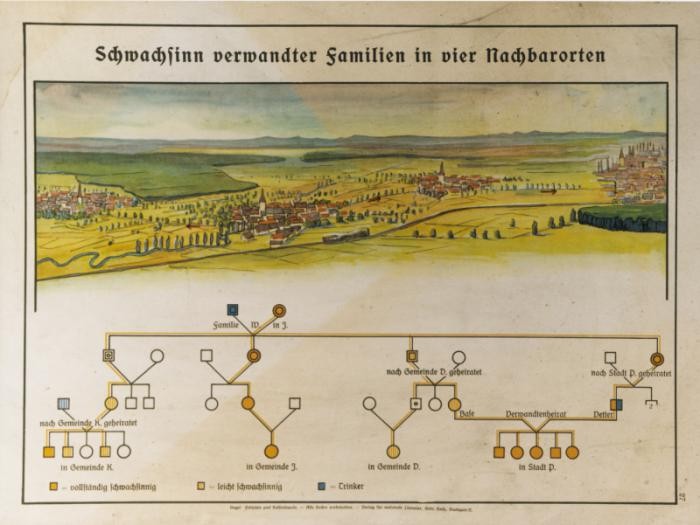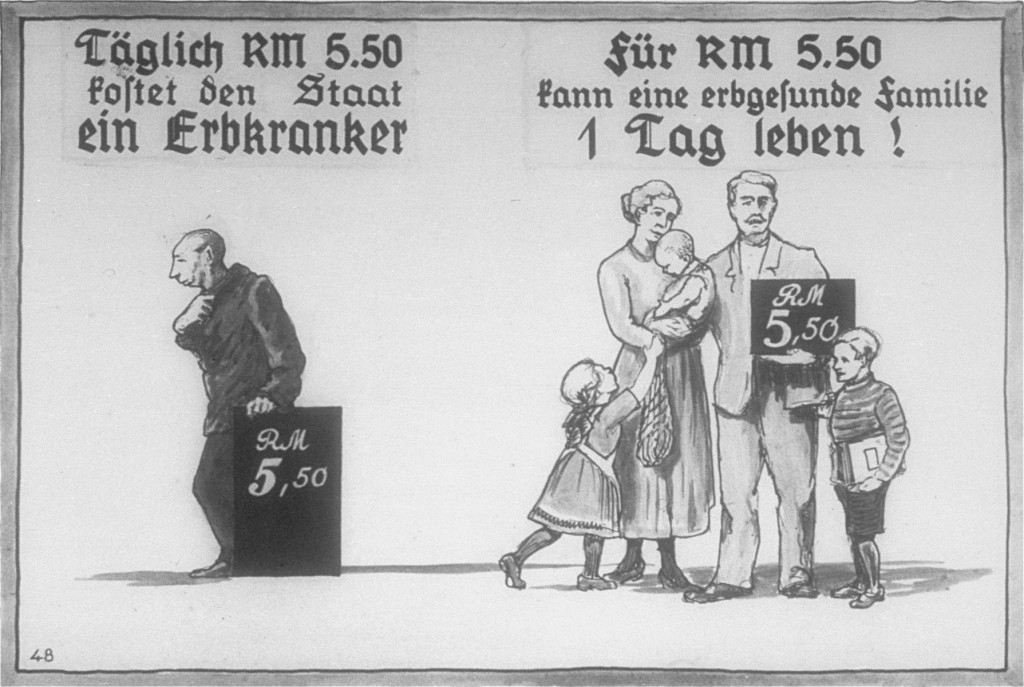Theories of eugenics, or “racial hygiene” in the German context, shaped many of Nazi Germany’s persecutory policies.

Nazi eugenics poster entitled "Feeble-mindedness in related families in four neighboring towns." This poster shows how "feeble-mindedness" and alcoholism are passed down from one couple to their four children and their families. The poster was part of a series entitled, "Erblehre und Rassenkunde" (Theory of Inheritance and Racial Hygiene), published by the Verlag für nationale Literatur (Publisher for National Literature), Stuttgart, Germany, ca. 1935.
Item View
Propaganda slide produced by the Reich Propaganda Office showing the opportunity cost of feeding a person with a hereditary disease. The illustration shows that an entire family of healthy Germans can live for one day on the same 5.50 Reichsmarks it costs to support one ill person for the same amount of time. Dated 1936.
Nazis defined individuals with mental, physical, or social disabilities as “hereditarily ill” and claimed such individuals placed both a genetic and financial burden upon society and the state.
Item ViewBenno Müller-Hill, professor of Genetics, University of Cologne, and author of Murderous Science, discusses genetics and eugenics.
[Photo credits: Getty Images, New York City; Yad Vashem, Jerusalem; Max-Planck-Institut für Psychiatrie (Deutsche Forschungsanstalt für Psychiatrie), Historisches Archiv, Bildersammlung GDA, Munich; Bundesarchiv Koblenz, Germany; Dokumentationsarchiv des österreichischen Widerstandes, Vienna; Kriemhild Synder: Die Landesheilanstalt Uchtspringe und ihre Verstrickung in nationalsozialistische Verbrechen; HHStAW Abt. 461, Nr. 32442/12; Privat Collection L. Orth, APG Bonn.]
Item View![At the Kaiser Wilhelm Institute for Anthropology, Human Genetics, and Eugenics, a racial hygienist measures a woman's features in ... [LCID: 78569] A woman with medium-length dark hair and light skin tone sits with her neck extended looking towards the ceiling. A man stands next to her with short dark hair, a mustache, and light skin tone. He is wearing a white lab coat and using a ruler to measure part of her neck. There is a lamp and camera set up around them.](https://encyclopedia.ushmm.org/images/large/ba256b8b-c19f-475c-92c5-bff0a5f6cfc5.jpeg)
At the Kaiser Wilhelm Institute for Anthropology, Human Genetics, and Eugenics, a racial hygienist measures a woman's features in an attempt to determine her racial ancestry. Berlin, Germany, date uncertain.
Item View![This photo originates from a film produced by the Reich Propaganda Ministry. [LCID: film01] Two men stand among several occupied wooden beds wearing white medical uniforms. White text along the bottom read, “Leben nur als Last” which translates to, “Life only as a burden.”](https://encyclopedia.ushmm.org/images/large/2ee91faf-6a84-49b4-88a1-7a2f7ffed943.jpg)
This photo originates from a film produced by the Reich Propaganda Ministry. It shows two doctors in a ward in an unidentified asylum. The existence of the patients in the ward is described as "life only as a burden." Such propaganda images were intended to develop public sympathy for the Euthanasia Program.
Item ViewPaul Eggert was categorized as "feeble-minded." At age 11, he was institutionalized and sterilized without his knowledge. Helga Gross attended a school for the deaf in Hamburg, Germany. She was sterilized in 1939, aged 16. At age 19, Dorothea Buck was diagnosed as schizophrenic and sterilized without her knowledge.
[Photo credits: Getty Images, New York City; Yad Vashem, Jerusalem; Max-Planck-Institut für Psychiatrie (Deutsche Forschungsanstalt für Psychiatrie), Historisches Archiv, Bildersammlung GDA, Munich; Bundesarchiv Koblenz, Germany; Dokumentationsarchiv des österreichischen Widerstandes, Vienna; Kriemhild Synder: Die Landesheilanstalt Uchtspringe und ihre Verstrickung in nationalsozialistische Verbrechen; HHStAW Abt. 461, Nr. 32442/12; Privat Collection L. Orth, APG Bonn.]
Item View
We would like to thank Crown Family Philanthropies, Abe and Ida Cooper Foundation, the Claims Conference, EVZ, and BMF for supporting the ongoing work to create content and resources for the Holocaust Encyclopedia. View the list of donor acknowledgement.